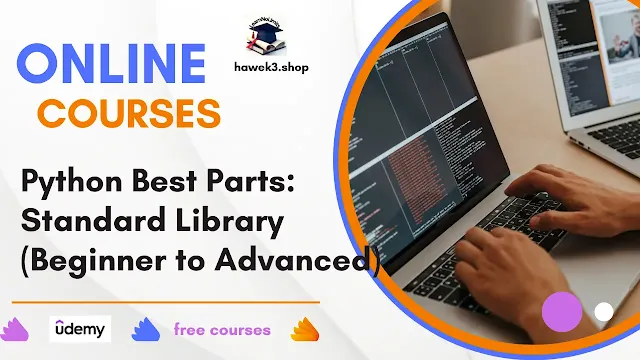Python Best Parts: Standard Library (Beginner to Advanced) — Because Great Code Hides in Plain Sight
TOP NEW FREE Python 3 programming training tutorial. Intermediate language introduction. Pro development code course.
Why Your Python Code Is Secretly Begging for a Makeover
Imagine this: You’ve written a script that works. It’s functional. It’s… fine. But deep down, you know it’s messy—like a closet stuffed with mismatched socks. You’re using loops for tasks Python could handle in one line. You’re manually parsing CSV files like it’s 1999. You’re writing 20 lines where 2 would do.
Here’s the truth: Python’s Standard Library is a treasure chest most programmers ignore. It’s packed with tools that turn clunky code into elegant, efficient poetry. This free course isn’t about memorizing syntax. It’s about discovering the secret shortcuts that make others ask, “How’d you do that so fast?”
Let’s upgrade from “it works” to “it sparkles.”
What You’ll Master: From Clunky to “How’d I Live Without This?”
📜 From Spaghetti Code to Python Poetry 🍝➡️📜
difflib: Visually compare texts like a detective spotting forged signatures.
Sorted: Sort lists of objects by any criteria—salary, age, or even Pokémon CP.
Enumerate: Number items in a loop without awkward counter variables.
🧠 Python’s Hidden Genius Moves
defaultdict: Dictionaries that auto-create missing keys (goodbye, KeyError!).
Counter: Count occurrences of anything—words, emojis, or how often your cat meows at 3 AM.
namedtuple: Tuples with named fields, so user[1] becomes user.email.
⚡️ Code Simplification Sorcery
List Comprehensions: Replace nested loops with one-liners so clean, they’re borderline art.
Map & filter: Process data without writing for loops (your keyboard’s F key will thank you).
csv: Read/write CSV files without Excel-induced rage.
By the end, you’ll write code that’s short, readable, and oddly satisfying—like Tetris blocks snapping into place.
Who This Course Is For (Spoiler: You’re Already Qualified)
This isn’t for coding prodigies. It’s for:
Self-Taught Programmers tired of Googling “Python better way to [X]”
Career Changers wanting to impress in their first tech role
Hobbyists who think, “There’s got to be a smarter way to analyze my D&D stats”
Anyone who’s ever written for i in range(len(list)): and felt a twinge of shame
If you’ve muttered, “My code works, but it’s ugly,” this is your intervention.
Prerequisites: What You Need (It’s Less Than You Think)
Bring:
Basic Python knowledge (variables, loops, functions)
A curiosity to learn why Python is called “batteries included”
Leave Behind:
The belief that “advanced” means “complicated”
Habits like reinventing wheels (we’ll give you better ones)
Course Content: 33 Minutes to Code Enlightenment
✨ The “Why Didn’t I Know This Sooner?” Toolkit ✨
difflib (2:56): Highlight text differences like a human git diff.
Sorted (2:35): Sort objects by multiple keys (e.g., sort users by age, then name).
Enumerate (1:06): Get loop indexes without i = 0 and i += 1.
pprint (1:21): Print nested dictionaries without eye strain.
Truthy/Falsy (2:24): Master Python’s truth testing (spoiler: [] is False).
📂 Real-World Superpowers
csv (3:03): Read CSV files into dictionaries, skip manual parsing.
Random (2:28): Generate lottery numbers or randomize quiz questions.
defaultdict (2:27): Build word frequency maps in 3 lines.
Counter (3:07): Find the most common element in a list (without loops).
🧩 Code Compression Techniques
Comprehensions (6:20): Transform loops into elegant one-liners.
Map & filter (2:55): Process lists functionally (yes, like in fancy languages).
Total runtime: 33 minutes. Less time than a lunch break, more impact than a 4-hour tutorial.
Why This Course Feels Like a Coffee Chat with a Coding Buddy
Zoli, your instructor, isn’t a detached expert—he’s a Python enthusiast who’s spent years curating these gems. He’s packaged them into bite-sized lessons that:
Use animations to demystify complex concepts.
Include challenges like analyzing baby names or fixing price gouging.
Feel like a friend saying, “Psst… want to see a cooler way?”
You’re not just learning tools. You’re adopting a philosophy: Write less code, solve more problems.
Stop Writing “Fine” Code. Start Writing “Wow” Code.
In the time it takes to brew coffee, you could:
Replace 10 lines of loops with a list comprehension.
Parse a CSV file without crying.
Generate a report comparing two legal contracts.
Click. Code. Grin when you realize, “I just did that in 2 lines.” If it clicks, keep going. If not? You’ve lost 33 minutes—but gained a meme-worthy coding story.
Learn More: Python Pandas For Your Grandpa

.webp)